|
|

|
|
Author
|
Topic: Apollo 14's Moon Trees and descendants
|
Gordon Reade
Member Posts: 335
From: USA
Registered: Nov 2002
|
 posted 09-06-2003 06:31 PM
posted 09-06-2003 06:31 PM
  
NASA release The "Moon Trees"Apollo 14 launched in the late afternoon of Jan. 31, 1971, on what was to be our third trip to the lunar surface. Five days later Alan Shepard and Edgar Mitchell walked on the moon while Stuart Roosa, a former U.S. Forest Service smoke jumper, orbited above in the command module. Packed in small containers in Roosa's personal kit were hundreds of tree seeds, part of a joint NASA and U.S. Forest Service project. Upon return to Earth, the seeds were germinated by the Forest Service. Known as the "Moon Trees," the resulting seedlings were planted throughout the United States (often as part of the nation's bicentennial in 1976) and the world. They stand as a tribute to astronaut Roosa and the Apollo program. The project began after Roosa was chosen for the Apollo 14 mission. Ed Cliff, chief of the Forest Service, knew of Stuart Roosa from his days as a smoke jumper and contacted him about bringing seeds into space. Stan Krugman of the Forest Service was put in charge of the project and selected the seeds for the experiment. Seeds were chosen from five different types of trees: Loblolly Pine, Sycamore, Sweetgum, Redwood, and Douglas Fir. The seeds were classified and sorted, and control seeds were kept on Earth for later comparison. Roosa carried about 400 to 500 seeds in his personal kit which stayed with him as he orbited the moon in the command module "Kitty Hawk" in February, 1971. Unfortunately, the canisters burst open during the decontamination procedures after their return to Earth, and the seeds got mixed together and were presumed to be no longer viable. Stan Krugman had the seeds sent to the southern Forest Service station in Gulfport, Mississippi and to the western station in Placerville, California to attempt germination. Surprisingly, nearly all the seeds germinated successfully, and the Forest Service had some 420 to 450 seedlings after a few years (some from cuttings). Some of these were planted with their earth-bound counterparts as controls, (as would be expected, after over twenty years there is no discernable difference) but most were given away in 1975 and 1976 to many state forestry organizations to be planted as part of the nation's bicentennial celebration. These trees were southern and western species, so not all states received trees. A Loblolly Pine was planted at the White House, and trees were planted in Brazil, Switzerland, and presented to the Emperor of Japan, among others. Trees have also been planted in Washington Square in Philadelphia, at Valley Forge, in the International Forest of Friendship, and at various universities and NASA centers. A list of Moon Tree locations can be found on NASA's website. Stuart Roosa was born on 16 August 1933, in Durango, Colorado. He worked for the Forest Service in the early 1950's as a smoke jumper fighting fires and later joined the Air Force and became a test pilot. He was one of 19 people selected for the astronaut class of 1966 and was part of the astronaut support crew for Apollo 9. Following Apollo 14, Roosa was backup command module pilot for Apollo's 16 and 17. He then worked on the Space Shuttle program until his retirement as a Colonel in the Air Force in 1976, the time when many of his trees were being planted. Sadly, Stuart Roosa passed away in December, 1994. The Moon Trees continue to flourish, a living monument to our first visits to the moon and a fitting memorial to Stuart Roosa. No list was ever kept nor any systematic tracking made of the disposition of all the trees. If you know of a Moon Tree, please send a message. |
RichieB16
Member Posts: 629
From: Oregon
Registered: Feb 2003
|
 posted 09-08-2003 01:45 AM
posted 09-08-2003 01:45 AM
   
Hey, one of those Apollo 14 trees planted by the forest service is on my school's grounds - I didn't know that! |
Gordon Reade
Member Posts: 335
From: USA
Registered: Nov 2002
|
 posted 09-08-2003 09:30 AM
posted 09-08-2003 09:30 AM
  
I'm planning a drive to Monterey, Calif. (about 80 miles south of where I live) to have a look at the Moon Tree there. I think taking those seeds on Apollo 14 was a great idea. My only regret is that I can't thank Roosa as he is no longer with us.It is interesting though that from more than 400 trees we only know the whereabouts of 45. I guess that's what happens when records are not kept. NASA should have flown more seeds to the moon and they should have made sure that all the countries on Earth were given a number of saplings. If they had, every major city would have a Moon Tree. |
Gordon Reade
Member Posts: 335
From: USA
Registered: Nov 2002
|
 posted 09-16-2003 10:45 AM
posted 09-16-2003 10:45 AM
  
Last weekend I drove down to Monterey California to see the moon tree they have there. It's an absolute beautiful Coast Redwood in a gorgeous park like setting. I wish you could all see it. It was surrounded by historic buildings on what must be one of the most beautiful places on earth.After viewing the tree I wandered into one of those old but very well cared for buildings. The Park Ranger informed me that I was in Colton Hall and we were standing in the very room where the California Constitutional Convention met in 1849, the birth place of present day California. "Gee I had no idea," I said. "I only came here to have a look at your Moon Tree." "Oh," he replied. "And just what is a Moon Tree?" At first I thought he was joking but he was not. He didn't know. They had all sorts of free brochures on self-guided walking tours of the grounds and the Colton Hall Museum but none of them made any mention of the Moon Tree. The Moon Tree did have a marker but it was small and unremarkable. Most people would not bother to read something like that. Now I'll have to write to the people who put out those brochures and ask them to add a few lines about their Moon Tree. |
Robert Pearlman
Editor Posts: 50932
From: Houston, TX
Registered: Nov 1999
|
 posted 02-15-2005 11:16 PM
posted 02-15-2005 11:16 PM
   
AmericanForests.org Press Release 'Moon Tree' Dedication Honors AstronautsStuart A. Roosa, the astronaut and smokejumper who carried tree seeds to the moon and back aboard Apollo 14, was remembered along with other astronauts with the planting of a 6-foot descendant of his Moon Trees at Arlington National Cemetery Wednesday, February 9. The tree is intended to honor all NASA's deceased astronauts. When Apollo 14 launched January 31, 1971, Col, Roosa (USAF) carried with him hundreds of loblolly pine, sycamore, sweetgum, redwood and Douglas-fir seeds. The seed project was intended to honor the U.S. Forest Service, for whom Roosa worked summers as a smokejumper, jumping from airplanes to battle forest fires, early in his career. The February 9 planting was hosted by the Roosa family. In announcing the event, son Christopher Roosa noted the recent anniversaries of several space program tragedies -- the Apollo I fire and the Challenger and Columbia disasters. "We also recently marked the 10th anniversary of my father passing away," he said. "By planting this tree, we want to honor how he and the other astronauts enriched our lives. They were dedicated, professional patriots who lived their lives on the edge of the envelope. They inspire us to reach for the stars in our own way." Col. Roosa, who served as command module pilot for the mission, passed away in December 1994; he had planned to plant Moon Sycamore descendants during a spring 1995 tree-planting tour with AMERICAN FORESTS' Historic Tree Nursery. Before his death Roosa expressed a hope that the Moon Tree descendants could encourage Americans to dream as big as the moon while planting trees to improve the quality of life on earth. Roosa's dream of a "Moon Trees" project appeared to be in doubt when Apollo 14 returned to earth and her contents underwent decontamination. In the process the seed packets burst open and it was feared the seeds had died. A Forest Service staff geneticist planted them anyway, and the seeds sprouted. In 1975, a moon seedling, a sycamore, was planted in front of the Forestry Science Building at Mississippi State University. Hundreds of so-called Moon Trees were planted around the country - many as part of the nation's Bicentennial in 1976 - including at the White House, NASA facilities, state capitols and at Valley Forge. Moon trees were planted in Brazil and Switzerland and another given to the Emperor of Japan. The Arlington Cemetery tree is a descendent of that first sycamore planted at Mississippi State. In attendance February 9 were representatives from NASA, the U.S. Forest Service, the military, and students from Cannelton Elementary School in Cannelton, Indiana, where one of the original Moon Trees, a sycamore, is planted at Camp Koch Girl Scout Camp. The tree was "discovered" and adopted in 1996 by Joan Gobel's 3rd grade class. Although NASA did not keep track of where all the Moon Trees went, it is hoping to track them down now. It has located a few dozen, but there were hundreds planted. Anyone knowing the location of a Moon Tree is asked to contact David Williams. |
spaceuk
Member Posts: 2113
From: Staffs, UK
Registered: Aug 2002
|
 posted 02-16-2005 08:26 AM
posted 02-16-2005 08:26 AM
  
If any one goes to Arlington I'd like see image of where the Roosa seedlings were planted please? |
thump
Member Posts: 578
From: washington dc usa
Registered: May 2004
|
 posted 02-16-2005 04:59 PM
posted 02-16-2005 04:59 PM
   
Anyone know where in the cemetery it was planted? |
Ken Havekotte
Member Posts: 3654
From: Merritt Island, Florida, Brevard
Registered: Mar 2001
|
 posted 03-21-2005 06:31 AM
posted 03-21-2005 06:31 AM
   
I attended the "Moon Tree 1976" Planting Ceremony at Kennedy Space Center on June 25, 1976. It was during KSC's Bicentennial Expo on Science and Technology when I was a young college student and "covered" the special "tree" event both as an aerospace journalist and avid enthusiast. I don't know why, but Col. Roosa wasn't a part of the formal program that day. Instead, Capt. Mitchell made the keynote address for the dedication and planting of the Moon Tree. Afterwards I had a few programs postmarked on the planting day and had Mitchell sign a couple for me on their front surfaces, and yes, I still have one of them in my Mitchell binder collection, but probably gave the other to a collector friend as that was merely 30 years ago. |
mmmoo
Member Posts: 579
From: London, England
Registered: May 2001
|
 posted 07-19-2005 10:43 AM
posted 07-19-2005 10:43 AM
   
Article on the Moon Trees grown from seeds taken aboard Apollo 14 by Stu Roosa.BBC News: Trees... from the Moon They have been to space and back and virtually all of them lived to tell the tale. There are more of them than there are astronauts and they are found all over the planet."They" are Moon Trees grown from seeds which journeyed to the Moon and back on board Apollo 14 in 1971. Says at the end of the article: The Moon Trees will be broadcast on BBC Radio Four at 2100 BST on Wednesday 20 July. The producer is Gabi Fisher. If you know the location of a Moon Tree, please let us know by sending an e-mail to moontrees@bbc.co.uk |
Andy McCulley
Member Posts: 249
From: Lansdale, PA
Registered: Jul 2001
|
 posted 07-20-2005 10:23 AM
posted 07-20-2005 10:23 AM
   
I have one of the second generation trees growing in my yard. I am going to have a plaque made describing the tree and dedicating it to my daughters.It's kinda cool. |
Robert Pearlman
Editor Posts: 50932
From: Houston, TX
Registered: Nov 1999
|
 posted 07-20-2005 02:08 PM
posted 07-20-2005 02:08 PM
   
collectSPACE/Science@NASA: In search of Moon Trees Scattered around our planet are hundreds of creatures that have been to the Moon and back again. None of them are human. They outnumber active astronauts 3:1. And most are missing.They're trees. "Moon Trees." |
spaceuk
Member Posts: 2113
From: Staffs, UK
Registered: Aug 2002
|
 posted 07-26-2005 10:14 AM
posted 07-26-2005 10:14 AM
  
I've had Moon Tree seeds for a long while now and have been on display at several exhibitions I have given. I usually display alongside other flown seeds and Ed White's mustard seed display.I assume the BBC wants to know about matured trees rather than seeds.
|
Robert Pearlman
Editor Posts: 50932
From: Houston, TX
Registered: Nov 1999
|
 posted 04-22-2009 04:52 PM
posted 04-22-2009 04:52 PM
   
NASA release NASA's Apollo 14 legacy continues with Earth Day tree plantingNASA, the National Arboretum and American Forests celebrated Earth Day and the 40th anniversary of the first Apollo moon landing with a tree planting ceremony April 22 at the National Arboretum in Washington, DC. The planting ceremony began at 1 p.m. EDT. NASA astronaut Stuart Roosa had been a U.S. Forest Service smoke jumper. During the Apollo 14 mission to the moon in 1971, he took along tree seeds from a Loblolly pine, sycamore, sweet gum, redwood, and Douglas fir. After returning to Earth, the U.S. Forest Service germinated these seeds, which grew into first-generation "moon trees." The moon trees have been planted throughout the United States, but the sycamore is the first to be planted at the National Arboretum. American Forests, the nation's oldest conservation organization, continues the legacy of this Apollo-era program by maintaining second-generation moon trees and making them available through its Historic Trees Program. 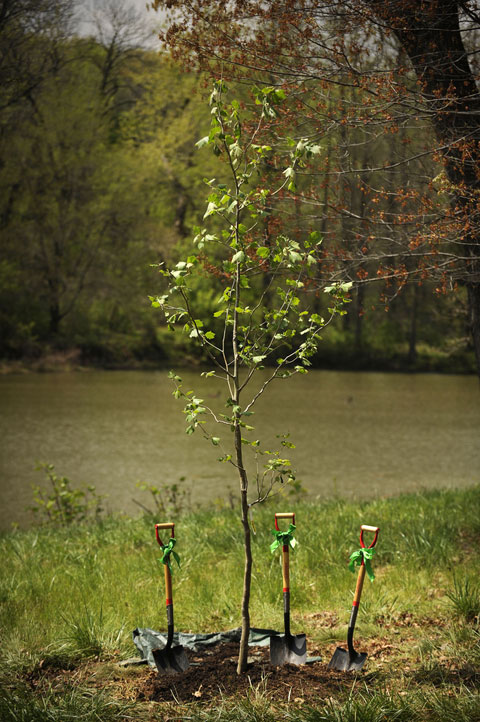 A second generation Sycamore "moon" tree was newly planted in celebration of Earth Day and the 40th Anniversary of the first Apollo moon landing at the US National Arboretum, Wednesday, April 22, 2009, in Washington. (NASA/Bill Ingalls) 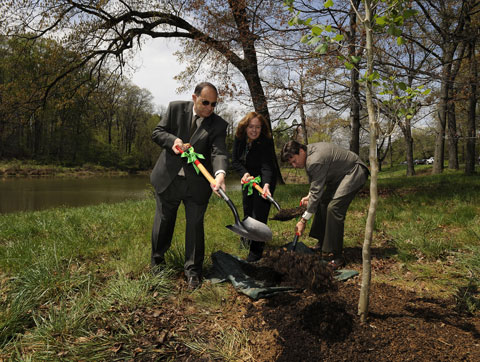 From left, Dr. Thomas Elias, Director of the US National Arboretum, Dr. Deborah Gangloff, Executive Director of American Forests, and, Mr. Alan Ladwig, Senior Advisor to the NASA Administrator, plant a second generation Sycamore "moon" tree in celebration of Earth Day and the 40th Anniversary of the first Apollo moon landing at the US National Arboretum. (NASA/Bill Ingalls) |
GACspaceguy
Member Posts: 2976
From: Guyton, GA
Registered: Jan 2006
|
 posted 04-22-2009 05:50 PM
posted 04-22-2009 05:50 PM
   
We are in the process of planting a Moon Tree on our property. We have cut down trees and cleared a sunny area. We will post photos once they are in the ground. |
Gordon Reade
Member Posts: 335
From: USA
Registered: Nov 2002
|
 posted 05-12-2009 05:39 PM
posted 05-12-2009 05:39 PM
  
Five and a half years on my Moon Tree is 12 feet tall and it looks great.I took this photo just this morning. Is that a good looking tree? Yes it is! I only wish that Stuart Roosa was still alive so that I could thank him myself. 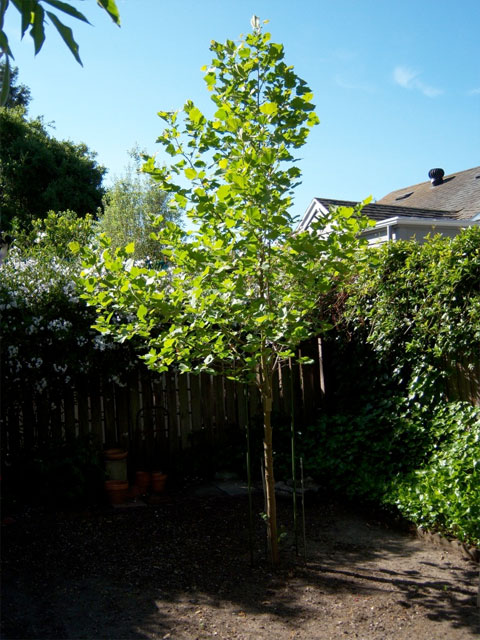 |
mdmyer
Member Posts: 900
From: Humboldt KS USA
Registered: Dec 2003
|
 posted 06-12-2009 09:07 AM
posted 06-12-2009 09:07 AM
   
Last Wednesday Miranda and I traveled to Atchison, KS to visit the Amelia Earhart Birthplace. We also visited the Atchison County Museum. They had some of Amelia's artifacts there, too. We had noticed a bronze statue of Amelia in the flyers promoting the town but we had not found that statue yet. We asked and they said it was in the Forest of Friendship. I asked what that was and they said it was a grove or forest of trees from each of the 50 States and 35 countries. They also said they had a Moon Tree there. She asked if I knew what that was and I said I did. Miranda and I decided to go to the Forest of Friendship. We found the bronze statue of Amelia and it was close to the Moon Tree.  This Moon Tree is an American Sycamore. If you look close you can see the statue of Amelia to the right of the tree. Also notice the sidewalk that circles the tree. It is a memorial to the Fallen Astronauts. 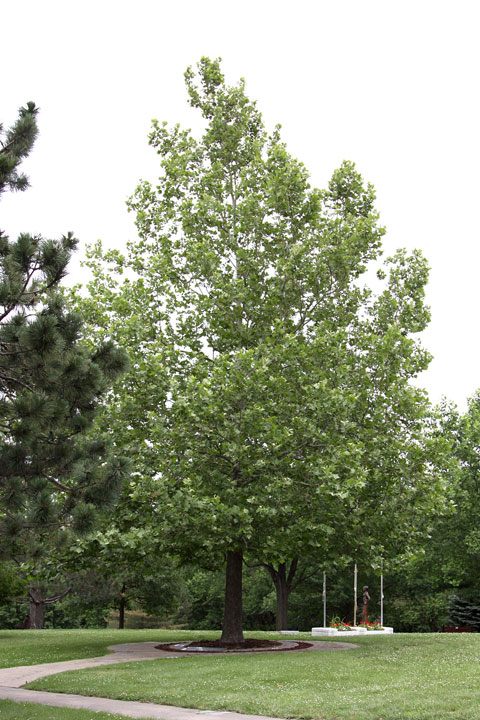 This marker is at the edge of the sidewalk leading up to the tree. 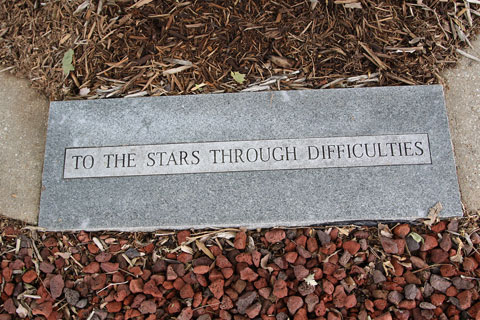 |
mdmyer
Member Posts: 900
From: Humboldt KS USA
Registered: Dec 2003
|
 posted 06-12-2009 09:07 AM
posted 06-12-2009 09:07 AM
   
Then this photo shows the base of the tree. The smaller markers have the names of the crew of Apollo 1 and the Challenger. 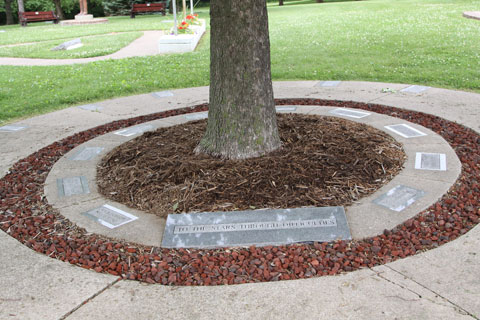 This photo shows the same tree but notice the black granite marker in the background. It is a memorial to the crew of the Columbia. 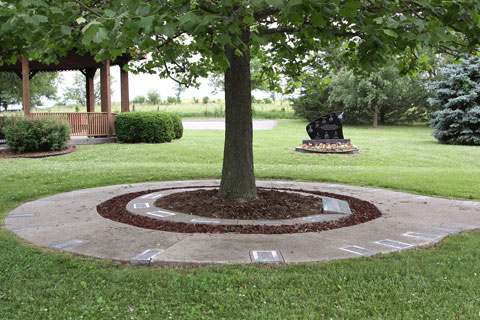 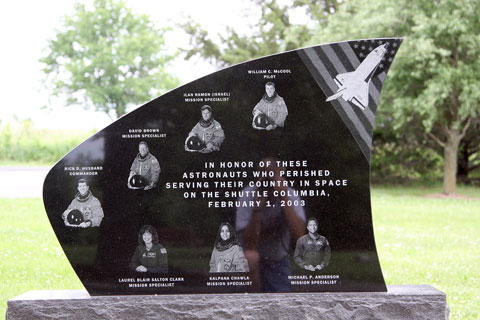
The walkway leading through the Forest of Friendship has about 1,200 markers or names in it of people. Most have played a part in the history of aviation. I thought it was a great tribute and use of the Moon tree. Before we left I plucked a few seed pods from the branches of the Moon tree. I doubt Stuart would have minded after all he loved trees. I have hopes of getting a tree to grow. |
Robert Pearlman
Editor Posts: 50932
From: Houston, TX
Registered: Nov 1999
|
 posted 02-09-2011 01:52 PM
posted 02-09-2011 01:52 PM
   
NASA feature A Race Against Time to Find Apollo 14's Lost VoyagersIn communities all across the U.S., travelers that went to the moon and back with the Apollo 14 mission are living out their quiet lives. The whereabouts of more than 50 are known. Many, now aging, reside in prime retirement locales: Florida, Arizona and California. A few are in the Washington, D.C., area. Hundreds more are out there -- or at least, they were. And Dave Williams of NASA's Goddard Space Flight Center in Greenbelt, Md., wants to find them before it's too late. The voyagers in question are not astronauts. They're "moon trees" -- redwood, loblolly pine, sycamore, Douglas fir, and sweetgum trees sprouted from seeds that astronaut Stuart Roosa took to the moon and back 40 years ago. "Hundreds of moon trees were distributed as seedlings," says Williams, "but we don't have systematic records showing where they all went." And though some of the trees are long-lived species expected to live hundreds or thousands of years, others have started to succumb to the pressures of old age, severe weather and disease. At least a dozen have died, including the loblolly pine at the White House and a New Orleans pine that was damaged by Hurricane Katrina and later removed. To capture the vanishing historical record, Williams, a curator at the National Space Science Data Center, has been tracking down the trees, dead or alive. His sleuthing started in 1996, prompted by an email from a third-grade teacher, Joan Goble, asking about a tree at the Camp Koch Girl Scout Camp in Cannelton, Ind. A simple sign nearby read "moon tree." "At the time, I had never heard of moon trees," Williams says. "The sign had a few clues, so I sent a message to the NASA history office and found more bits and pieces on the web. Then I got in touch with Stan Krugman and got more of the story." Krugman had been the U.S. Department of Agriculture Forest Service's staff director for forest genetics research in 1971. He had given the seeds to Roosa, who stowed them in his personal gear for the Apollo 14 mission. The seeds were symbolic for Roosa because he had fought wildfires as a smoke jumper before becoming an Air Force test pilot and then an astronaut. The seeds flew in the command module that Roosa piloted, orbiting the moon 34 times while astronauts Alan Shepard Jr. and Edgar Mitchell walked -- and in Shepard's case, played a little golf -- on the moon. Back then, biologists weren't sure the seeds would germinate after such a trip. Few experiments of this kind had been done. A mishap during decontamination procedures made the fate of the seeds even less certain: the canister bearing the seeds was exposed to vacuum and burst, scattering its contents. But the seeds did germinate, and the trees seemed to grow normally. At Forest Service facilities, the moon trees reproduced with regular trees, producing a second generation called half-moon trees. By 1975, the trees were ready to leave the Forest Service nurseries. One was sent to Washington Square in Philadelphia to be the first moon tree planted as part of the United States Bicentennial celebrations; Roosa took part in that ceremony. Another tree went to the White House. Many more were planted at state capitals, historic locations and space- and forestry-related sites across the country. Gerald Ford, then the president, called the trees "living symbol[s] of our spectacular human and scientific achievements." When Williams could find no detailed records of which trees went where, he created a webpage to collect as much information as possible. A flurry of emails came in from people who either knew of or came upon the trees. "About a year after I put the webpage up, someone contacted me and asked why I didn't have the moon tree at Goddard listed," he says. "I hadn't known it was there!" Goddard's moon tree is a sycamore, planted in 1977 next to the visitors' center. Williams has so far listed trees in 22 states plus Washington, D.C., and Rio Grande do Sul, Brazil. In many cases, the trees' extraordinary pedigrees were recorded on plaques or in newspaper clippings commemorating the event. Whenever possible, Williams has posted photos of the trees. Second-generation moon trees, also tracked by Williams, continue to be planted. On Feb. 9, 2005, the 34th anniversary of the Apollo 14 splashdown, a second-generation sycamore was dedicated at Arlington National Cemetery "in honor of Apollo astronaut Stuart A. Roosa and the other distinguished Astronauts who have departed our presence here on earth." At the invitation of Roosa’s family, both Williams and a group of students from Cannelton attended the ceremony. Another sycamore was planted at the U.S. National Arboretum in Washington, D.C., on April 22 (Earth Day), 2009. And on Feb. 3, 2011, one was planted in Roosa's honor at the Infinity Science Center, which is under construction at NASA's Stennis Space Center in Mississippi. Rosemary Roosa, the astronaut's daughter, attended the Stennis ceremony. Her father, she says, was a strong supporter of science and space exploration, and she hopes the trees will serve as a reminder of the accomplishments of the U.S. space program as well as an inspiration to "reach for the stars." People who know of the special legacy of the trees periodically check on them and contact Williams if a tree gets sick or knocked down by a storm. "Sometimes, I get an email from someone who went to the site where the tree used to be, and it's just gone," he says. "There's no sign of it, and we don't know what happened." "I think when people are aware of the heritage of the trees, they usually take steps to preserve them," Williams adds, recalling one tree that was nearly knocked down during a building renovation. "But sometimes people aren't aware. That's why we want to locate as many as we can soon. We want to have a record that these trees are -- or were -- a part of these communities, before they're gone." |
Hart Sastrowardoyo
Member Posts: 3466
From: Toms River, NJ
Registered: Aug 2000
|
 posted 02-09-2011 03:59 PM
posted 02-09-2011 03:59 PM
   
A second-generation (I believe — I know it's not a first-gen) Moon Tree is on the campus of Georgian Court University, Lakewood, New Jersey. (GCU is also a NASA Educator Resource Center.) I don't have a photo of it or the plaque, but if need be, I can contact them and get a shot of it. |
fredtrav
Member Posts: 1799
From: Birmingham AL
Registered: Aug 2010
|
 posted 02-10-2011 05:21 PM
posted 02-10-2011 05:21 PM
   
There was a front page article in yesterday's Birmingham News about the Moon Trees in Alabama.There are four alive: one sycamore and three loblolly pines. The sycamore is at the Birmingham Botanical Gardens and is about 90 feet tall and is in good health. One of the loblolly pines is at the State Capitol by a statue of Albert Patterson, one is at Ivy Green in Tuscumbia which is Helen Keller's birthplace and the other is in Troy, AL. Trees planted in Auburn, the U.S. Space and Rocket Center in Huntsville, and at the Veterans Hospital in Tuskegee are no longer alive. |
Robert Pearlman
Editor Posts: 50932
From: Houston, TX
Registered: Nov 1999
|
 posted 02-03-2016 12:00 AM
posted 02-03-2016 12:00 AM
   
collectSPACE Moon mission's living monuments: Apollo 14's 'Moon Trees' 45 years laterThey are spread across the United States, standing as living monuments to a moon mission 45 years ago this week. The "Moon Trees" — redwoods, loblolly pines, sycamores, Douglas firs and sweetgums sprouted from seeds carried to the moon and back between Jan. 31 and Feb. 9, 1971 — are reminders of the Apollo 14 mission, even if some, if not many, of the trees' locations have now been lost to the passage of time. 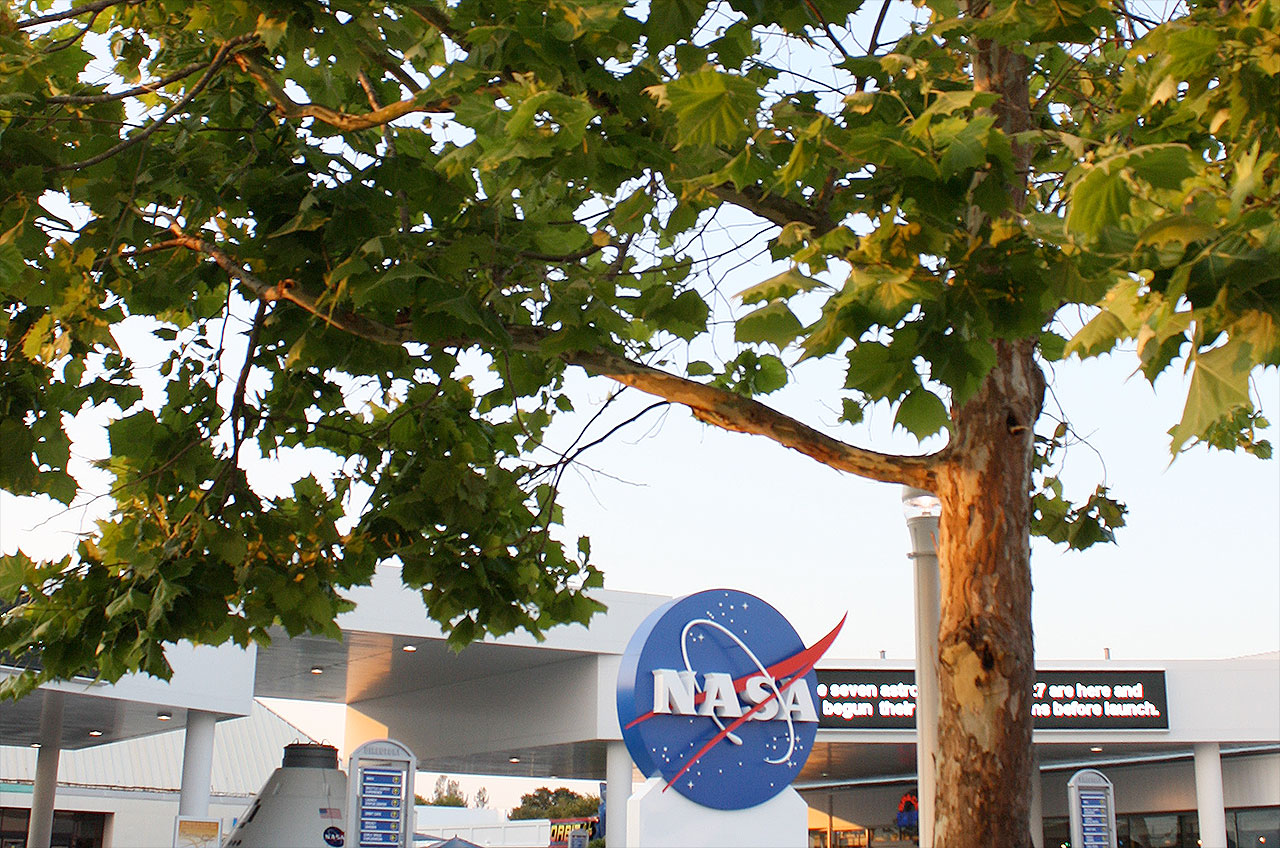 |
Hart Sastrowardoyo
Member Posts: 3466
From: Toms River, NJ
Registered: Aug 2000
|
 posted 06-30-2016 10:25 AM
posted 06-30-2016 10:25 AM
   
Philadelphia's Moon Tree, a sycamore, died in 2011, reports Atlas Obscura, but was replaced by a clone from clippings of the original tree. It's at Washington Square Park, 6th and Walnut streets, just south of Independence Hall. |
Cozmosis22
Member Posts: 1115
From: Texas * Earth
Registered: Apr 2011
|
 posted 06-30-2016 07:17 PM
posted 06-30-2016 07:17 PM
  
Is there a tree at Johnson Space Center in Houston? The "Moon Trees" website does not seem to list one there. |
Robert Pearlman
Editor Posts: 50932
From: Houston, TX
Registered: Nov 1999
|
 posted 06-30-2016 07:20 PM
posted 06-30-2016 07:20 PM
   
There is no tree (yet) at Johnson Space Center. There was one recently planted at Rice University and there are plans to add trees at Space Center Houston and as part of the memorial grove at Johnson. |
GACspaceguy
Member Posts: 2976
From: Guyton, GA
Registered: Jan 2006
|
 posted 06-30-2016 08:13 PM
posted 06-30-2016 08:13 PM
   
We picked up two saplings of a moon tree sibling from the American Arbor Society. One did not make it but the other is about 10' tall after 6 years.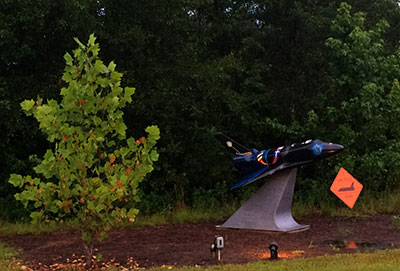 |
Robert Pearlman
Editor Posts: 50932
From: Houston, TX
Registered: Nov 1999
|
 posted 12-30-2016 11:20 AM
posted 12-30-2016 11:20 AM
   
A second-generation moon tree planted behind the Paper Products Company building on Queen City Avenue in Cincinnati, Ohio is slated to be cut down sometime in the next two years, the Cincinnati Enquirer reports. The South Fairmount moon tree is one of only three listed in Ohio. A first-generation tree stands in Friendship Park outside Steubenville, and another second-generation tree lives on a private residence in Canal Winchester, Ohio....the Paper Products Company building, built in 1900 and obtained by Smith's father in 1947, is now boarded up and owned by the Metropolitan Sewer District. [Dennis] Smith moved his company to West Chester in 2015. "They needed our property down there," Smith said. The MSD's $193 million Lick Run Project is scheduled to bring down 91 buildings, sheds and garages in the neighborhood. The project is designed to keep stormwater out of the combined sewer system, and will include new storm sewers, storm water detention basins, biofiltration gardens and the creation of a mile-long constructed waterway that will mimic a natural stream. As part of the project, the famous sycamore will be removed. The removal has not been scheduled, but the project is scheduled for completion in 2018. However, the support of Smith and others means the Cincinnati moon tree will have a legacy. The MSD had Lagergren Nursery in Hamilton make clones of the moon tree, which will be planted through the new greenspace. Smith worked to save the tree, collecting letters from local astronomy organization and requesting help from the families of notable astronauts. While Smith believes it's important for people to remember the trees as a symbol of our nation's lunar missions, he seems to be at peace with the compromise. "A couple people have suggested that maybe we chop the tree up and sell it as moon mulch, which I thought was pretty funny," he said. |
Glint
Member Posts: 1116
From: New Windsor, Maryland USA
Registered: Jan 2004
|
 posted 07-20-2017 06:17 PM
posted 07-20-2017 06:17 PM
   
Saw the King of Prussia (Pennsylvania) tree this week. I expect that the plaque was recast as at the time of its planting in 1976 the property was owned by G.E. Astro. The site is now part of Lockheed-Martin Space Systems Company. 
|
Robert Pearlman
Editor Posts: 50932
From: Houston, TX
Registered: Nov 1999
|
 posted 07-23-2017 09:42 PM
posted 07-23-2017 09:42 PM
   
Rosemary Roosa has resigned her position as the executive director of the Walter Anderson Museum of Art to found The Moon Tree Foundation. The Moon Tree Foundation is a 501(c)(3) nonprofit with the main purpose of educating the world's society about an important part of our history, the United States Space Program, the United States Forest Service, and to inspire the globe's population with the living legacy of the Moon Trees. The Foundation will also produce several educational documentaries, including one called "The Moon Trees" which talks about the history of space travel and moon tree seeds. It also plans to provide seeds and plant moon trees across the country and around the world to "promote peace and unification of our planet." |
GACspaceguy
Member Posts: 2976
From: Guyton, GA
Registered: Jan 2006
|
 posted 07-31-2017 08:23 AM
posted 07-31-2017 08:23 AM
   
I swung by the Kennedy Space Center Visitor Complex this weekend to renew my annual pass as well as to see spacecraft. As I was leaving the center, the Apollo 14 sycamore tree caught my attention. While I certainly am not an arborist, the tree looks like it could use some TLC. Anyone know more about these trees to comment?
There has been some construction around there lately and I wonder if that has some impact on the limbs that appear dead.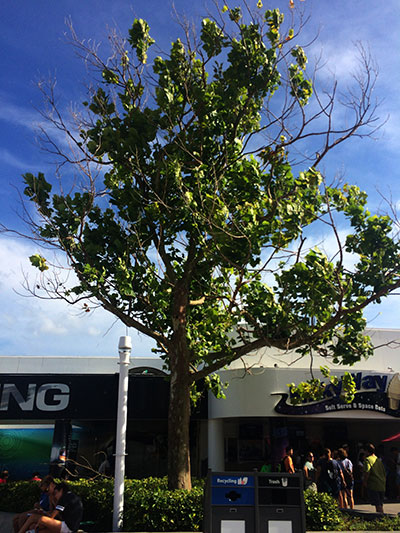 |
Charlie16
Member Posts: 543
From: Italy
Registered: Dec 2010
|
 posted 08-01-2017 01:27 AM
posted 08-01-2017 01:27 AM
   
My little contribution to the history: In 2011, thanks to Rosemary Roosa, I got in Italy a second generation Moon Tree. Now he grew up. Hope it will be gets tall and robust for remembers the Apollo missions and Stu Roosa. |
Robert Pearlman
Editor Posts: 50932
From: Houston, TX
Registered: Nov 1999
|
 posted 11-09-2019 01:47 PM
posted 11-09-2019 01:47 PM
   
Vice President Mike Pence was joined by Buzz Aldrin, Neil Armstrong's son Rick, Stu Roosa's daughter Rosemary and a small audience of space community representatives (including United Launch Alliance CEO Tory Bruno) to plant a second generation Moon Tree at the Naval Observatory in Washington, D.C. on Friday (Nov. 8).From Second Lady Karen Pence via Twitter: The Vice President's Residence has a new addition that is out of this world! We celebrated the 50th anniversary of the moon landing with the planting of a Moon Tree and in memory of Apollo 14 astronaut Col. Stuart Roosa — who carried tree seeds in lunar orbit as his way of paying tribute to the US Forest Service. 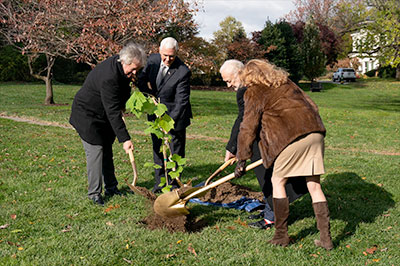 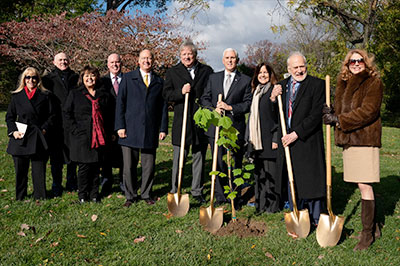
|
Robert Pearlman
Editor Posts: 50932
From: Houston, TX
Registered: Nov 1999
|
 posted 10-09-2020 08:01 PM
posted 10-09-2020 08:01 PM
   
A moon tree has taken its place on 11th Avenue in Hutchinson, Kansas. Hutchinson's young tree waited patiently in Carla Stanfield's office at the Cosmosphere — the coronavirus pandemic pushed back plans to plant the tree during the Apollo mission anniversary events this spring."Alright, little moon tree," the public relations coordinator laughed as she patted soil around the root ball. "You get to be a real tree now." Hutchinson's moon tree is planted in the Cosmosphere's team-building ropes course area, across 11th Avenue from the Smithsonian-affiliated museum. |
Charlie16
Member Posts: 543
From: Italy
Registered: Dec 2010
|
 posted 10-11-2020 04:39 PM
posted 10-11-2020 04:39 PM
   
Second generation Loblolly pine grown from a cutting planted 12 October 2011 at the Pineta Park of the Astronomical Observatory in Tradate, Italy. Thanks to Rosemary Roosa. |
PeterMart
Member Posts: 19
From: Texas
Registered: Aug 2007
|
 posted 10-18-2020 01:50 PM
posted 10-18-2020 01:50 PM
   
An original can be found in front of the police station in Holliston, Massachusetts, the small town outside of Boston where I grew up. |
Paul78zephyr
Member Posts: 798
From: Hudson, MA
Registered: Jul 2005
|
 posted 02-09-2021 09:00 AM
posted 02-09-2021 09:00 AM
  
On the 50th anniversary of Apollo 14 please dont forget the Moon Trees! There is one (Sycamore) about 25 miles from where I live in eastern Massachusetts that my son and I visited last summer. It is the one in Holliston MA that is linked in PeterMart's post above. |
Shuttlewatcher
Member Posts: 10
From: Tampa, Fl, Hills.
Registered: Jun 2002
|
 posted 11-01-2021 07:26 PM
posted 11-01-2021 07:26 PM
   
I've been traveling the country documenting the location and health of the Moon Trees. Many are thriving but some are ridden with disease and Pine Beatle infestation. Most of them have no identification plaques, lost in paperwork, and destroyed by people who did not know what they had.If you know of a moon tree, please send me the location so I can put in my data base foe future related projects. |
Robert Pearlman
Editor Posts: 50932
From: Houston, TX
Registered: Nov 1999
|
 posted 02-12-2022 01:32 PM
posted 02-12-2022 01:32 PM
   
Richard Hollingham on "The Trees Grown from Space-Faring Seeds" for the BBC. In a grey plastic plant pot on a windowsill somewhere in southern England, Royal Astronomical Society (RAS) administrator Richard O'Sullivan is attempting to grow an American sycamore tree.As anyone who's ever successfully nurtured a plant from seed knows, this is an achievement in itself. But this is no ordinary sycamore sapling. Its provenance can be traced back to a mission to the Moon in 1971, when astronaut Stuart Roosa carried 500 tree seeds in his Apollo 14 spacecraft. Trees grown from these seeds became known as "Moon Trees". Assuming the plant continues to flourish, O'Sullivan's will be a rare third-generation Moon Tree. |
Robert Pearlman
Editor Posts: 50932
From: Houston, TX
Registered: Nov 1999
|
 posted 02-13-2023 08:28 AM
posted 02-13-2023 08:28 AM
   
City of Nassau Bay release Moon Tree LaunchThe City of Nassau Bay is so excited to announce two special Moon Tree planting ceremonies held on Friday, Feb. 10 and Saturday, Feb. 11, 2023. The trees were planted at City Hall and David Braun Park, respectively. This incredible addition to the community was made possible through a partnership between the City's Parks and Recreation Committee led by City Councilmember Michelle Weller, Gary Mossman — former Mayor Pro Tem and current City Committee member — and the Moon Tree Foundation, a nonprofit organization dedicated to educating the public about the United States Space Program. "Through a program at Webster Presbyterian Church, we met Rosemary Roosa, President of the Moon Tree Foundation," Mossman said. "The church worked with her to get several Moon Trees planted, and when she was present for that ceremony, we talked about getting some of the trees for Nassau Bay." The fascinating history behind the Moon Trees reaches back to Apollo 14, the NASA Mission that was launched in the late afternoon of January 31, 1971. During the mission, Astronauts Alan Shepard and Edgar Mitchell would become the fifth and sixth men to walk on the Moon. While Shepard and Mitchell explored the surface, Astronaut Stuart Roosa – Rosemary Roosa's father – orbited above. On his command module, he carried hundreds of seeds that would eventually become "Moon Trees." "The seeds Stuart Roosa took into space were brought back, planted, and successfully grew into trees that are 60-75 feet tall today," Mossman said. "As they grew and matured, the Moon Tree Foundation was formed and began planting the seeds and growing saplings. Over time, they were able to take the DNA from those trees and create new offspring. This means the trees we're getting should have the same DNA as those original trees." The two planting ceremonies were followed by programs at City Hall, which featured a panel discussion including individuals associated with the Apollo 14 mission as well as the NASA Artemis program, which will also carry seeds to the Moon. | |
Contact Us | The Source for Space History & Artifacts
Copyright 2023 collectSPACE.com All rights reserved.

Ultimate Bulletin Board 5.47a
|
|

|
 advertisement advertisement

|



























